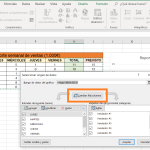In the business world, competitive analysis is one of the most powerful tools for improvement and growth. However, beyond simply studying your competitors, it is essential to understand what they do well so you can adapt it to your strategy and gain an advantage. Knowing your competitors’ strengths allows you to identify opportunities, improve your value proposition, and differentiate yourself in the market. In this article, we explore how to conduct an effective analysis to understand your competitors’ strengths and how to use that information to your benefit.
1. Why Is It Important to Know What Your Competitors Do Well?
Competitive analysis is not just about identifying weaknesses; it’s about understanding what your competitors are doing right. This allows you to:
- Learn from their successes: By analyzing their effective strategies, you can replicate their best practices and adapt them to your needs.
- Identify market trends: Successful companies are often the first to spot and capitalize on new trends. Understanding what they do well can help you stay ahead of these changes.
- Improve your value proposition: Knowing what customers like about your competitors can help you enhance your offering, whether in products, services, or customer experience.
2. Steps to Conduct a Competitive Analysis Focused on Strengths
Step 1: Identify Your Direct and Indirect Competitors
The first step is knowing who your competitors are. You should analyze not only those who sell similar products or services but also those offering alternatives that fulfill the same consumer need.
- Direct competitors: Those who sell similar products or services and compete in the same market.
- Indirect competitors: Businesses that offer different products or services but satisfy the same need or solve the same problem as your offering.
Step 2: Study Their Product or Service Offering
One of the first things to evaluate is the quality of your competitors’ products or services. Take the time to research:
- What are their best-selling products or services?
- What is the value proposition of these products?
- What features stand out in their offerings?
- What are their pricing strategies, and how are they positioned in the market?
Analyzing what aspects of their offer stand out in the market will give you an idea of what they are doing well. If customers prefer their product, it’s because it meets a need or provides an advantage over others.
Step 3: Analyze the Customer Experience
Customer experience is a key factor in many companies’ success. Study how your competitors interact with their customers:
- How is their customer service? Do they respond quickly to inquiries and comments?
- Do they offer a seamless shopping experience (both online and offline)?
- Do they have a loyalty program or exclusive benefits for returning customers?
If customer experience is one of your competitors’ strengths, you should incorporate it into your strategy, as it significantly impacts customer loyalty and retention.
Step 4: Review Their Marketing Strategies
Your competitors’ marketing strategies are a valuable source of information. Carefully analyze:
- Marketing channels: Where are they active? Do they use social media, email marketing, SEO, paid ads, etc.?
- Key messages: What message are they conveying to their audience? How do they communicate, and what tone do they use?
- Promotions and offers: Are they offering discounts, promotions, or exclusive content to attract customers?
By analyzing these tactics, you can identify the most effective ways to attract and retain customers in your industry.
Step 5: Observe Their Online Presence and Social Media
Nowadays, online presence is crucial for most businesses. Analyze:
- How do they present themselves on their websites and social media?
- What type of content do they share?
- How do they engage with their followers?
- What level of engagement do their posts achieve?
The interaction they generate, the quality of the content they share, and how they manage their social media can provide clues about how they build a loyal community and position their brand.
3. Useful Tools for Competitive Analysis
There are several tools and platforms that can help you gather valuable insights into what your competitors are doing well. Some of the most recommended ones are:
- SEMrush: Helps analyze your competitors’ SEO and paid advertising strategies, including keyword and web traffic details.
- BuzzSumo: Ideal for analyzing which content performs best on your competitors’ blogs and social media.
- Social Blade: Allows you to track your competitors’ social media growth, including follower count and posting frequency.
- Google Alerts: Set up alerts about competitors and their online activities to stay informed of their moves.
4. How to Leverage What Your Competitors Do Well
Once you have identified your competitors’ strengths, it’s time to use that information to your advantage:
- Adapt successful strategies: If your competitors are succeeding with certain messages or tactics, consider adapting them for your business.
- Improve your offering: If your competitors have a successful product, evaluate whether you can enhance your own offering to compete directly or differentiate yourself.
- Innovate in customer experience: If your competitors excel in customer service, find ways to offer an even better experience.
- Keep improving: The goal is not just to copy what they do well but to take inspiration and always stay one step ahead. Continuous improvement should be the objective of any competitive analysis.
5. Conclusion: Competitive Analysis as a Growth Tool
Competitive analysis not only helps you identify what your competitors are doing well but also allows you to understand how you can differentiate yourself and surpass them. By strategically using this information, you can adjust your tactics and optimize your business to seize opportunities and enhance your competitiveness.
It’s not about copying others but learning from them and taking advantage of opportunities that your competitors might be missing. Remember, the market is constantly evolving, and competitive analysis should be an ongoing process!



